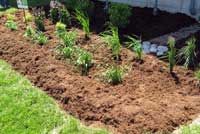All About Rain Gardens
What Is A Rain Garden?

A rain garden is a garden of native shrubs, perennials, and flowers planted in a small depression, which is generally formed on a natural slope. It is designed to temporarily hold and soak in rain water runoff that flows from roofs, driveways, patios or lawns. Rain gardens are effective in removing up to 90% of nutrients and chemicals and up to 80% of sediments from the rainwater runoff. Compared to a conventional lawn, rain gardens allow for 30% more water to soak into the ground.
A rain garden is not a water garden. Nor is it a pond or a wetland. Conversely, a rain garden is dry most of the time. It typically holds water only during and following a rainfall event. Because rain gardens will drain within 12-48 hours, they prevent the breeding of mosquitoes.
Why Is Rainwater Runoff A Problem?
Every time it rains, water runs off impermeable surfaces, such as roofs or driveways, collecting pollutants such as particles of dirt, fertilizer, chemicals, oil, garbage, and bacteria along the way. The pollutant-laden water enters storm drains untreated and flows directly to nearby streams and ponds. The US EPA estimates that pollutants carried by rainwater runoff account for 70% of all water pollution.
Rain gardens collect rainwater runoff, allowing the water to be filtered by vegetation and percolate into the soil recharging groundwater aquifers. These processes filter out pollutants.

What Makes A Rain Garden Different From A Traditional Garden?
In the design of a rain garden, typically six to twelve inches of soil is removed and altered with tillage, compost and sand to increase water infiltration. The type of alteration to the soil depends on the current soil type, so it is a good idea to obtain a soil test.
Rain gardens are generally constructed on the downside of a slope on your property and collect rainwater runoff from the lawn, roof and/or the driveway. Once water collects in the rain garden, infiltration may take up to 48 hours after a major rainfall. Also, rain gardens incorporate native vegetation; therefore, no fertilizer is needed and after the first year, maintenance is usually minimal.

